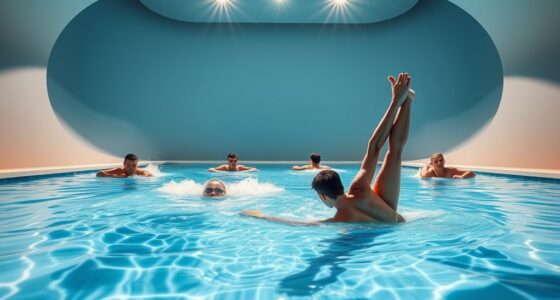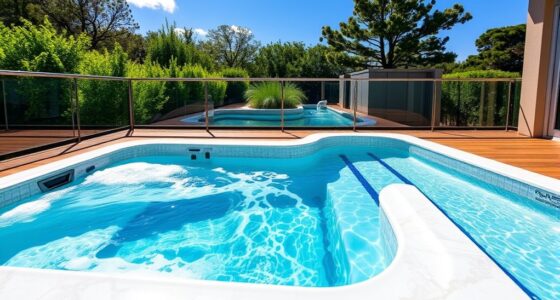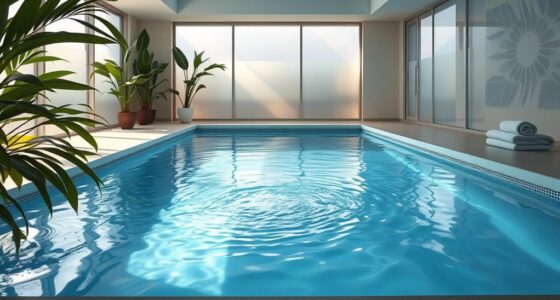When choosing a swim spa cover, look for those with high-quality insulation like thick foam layers that keep heat in and reduce energy costs. Durable materials such as marine-grade vinyl and reinforced shells resist weather and wear, ensuring long-lasting protection. For ease of use, consider lightweight covers with handles or hydraulic systems that make removal simple. Paying attention to proper fit and construction enhances thermal performance and convenience—if you explore further, you’ll discover more tips to select the perfect cover.
Key Takeaways
- Insulation materials like EPS and polyurethane foam enhance thermal retention and energy efficiency.
- Durable covers made from marine-grade vinyl and reinforced shells resist damage and extend lifespan.
- Lightweight handles, lifters, and hydraulic systems make cover removal and replacement easier.
- Precise fit and reinforced seams prevent heat loss and improve overall construction quality.
- High-quality insulation and construction boost thermal performance, reducing energy costs and maintaining water temperature.

Choosing the right swim spa cover is vital to protect your investment and maintain your spa’s performance. The type of cover you select can influence how well your spa retains heat, how easy it is to operate, and how long it lasts. When evaluating different options, consider the insulation materials used in the cover, as they directly impact thermal performance and energy efficiency. High-quality insulation materials, such as expanded polystyrene (EPS) or polyurethane foam, are key to minimizing heat loss. Thicker, denser foam layers typically provide better insulation, helping you save on energy costs and keep the water at your desired temperature longer.
Choosing a cover with high-quality insulation like EPS or polyurethane foam boosts heat retention and energy efficiency.
Beyond insulation, cover durability plays an essential role in ensuring your investment stands the test of time. A durable cover resists cracking, tearing, and UV damage, especially if you live in an area with extreme weather conditions or high sun exposure. Look for covers made with heavy-duty materials like marine-grade vinyl or reinforced polymer shells, which withstand the elements better than cheaper alternatives. These materials not only extend the lifespan of your cover but also maintain their appearance and protective qualities over time. Properly durable covers also resist mold, mildew, and water absorption, which can compromise insulation and lead to costly repairs.
Ease of use is another important factor. A well-designed cover should be lightweight enough for you to remove and replace easily, without straining your back. Many covers come with handles, lifters, or hydraulic systems that make this process smoother. When considering different types, think about how often you’ll need to access the spa and how convenient it is to handle the cover. Some models feature hinged sections or lift assist mechanisms that reduce effort and make maintaining your spa more straightforward.
In addition to insulation materials and cover durability, the overall construction quality influences how well your cover performs over time. Top-tier covers often have reinforced seams and high-quality hinges that prevent splitting or breaking. This ensures the cover remains secure and effective, preventing debris from entering and heat from escaping. Also, consider the fit—an exact fit minimizes heat loss and maximizes energy efficiency. Moreover, thermal performance is directly impacted by the quality of insulation and construction, influencing both energy consumption and comfort.
Ultimately, choosing a swim spa cover with superior insulation materials and robust construction guarantees your spa stays warm, your energy bills stay low, and your investment remains protected. It’s a small step that makes a big difference in your overall spa experience, providing both peace of mind and enhanced enjoyment.
Frequently Asked Questions
How Long Do Swim Spa Covers Typically Last?
You can expect your swim spa cover to last about 3 to 5 years, depending on its cover durability and material lifespan. High-quality covers with UV-resistant and weatherproof materials tend to last longer, while lower-quality ones may need replacement sooner. Proper maintenance, like cleaning and avoiding sharp objects, can extend its life. Keep an eye on signs of wear to replace it before it compromises thermal performance or ease of use.
Can Covers Be Customized for Different Spa Sizes?
Did you know that over 80% of spa owners opt for custom-fit covers? You can definitely get covers tailored to your spa’s specific size, ensuring better insulation and easier use. Custom fit cover sizing means your cover will match your spa’s dimensions perfectly, providing ideal thermal performance and preventing heat loss. So, yes, covers can be customized to suit your spa’s unique shape and size, making your experience more comfortable and energy-efficient.
Are There Eco-Friendly Cover Options Available?
Yes, eco-friendly cover options are available. You can choose covers made from eco-friendly materials like recycled foam or sustainable fabrics, which reduce environmental impact. Look for covers produced through sustainable manufacturing processes that prioritize minimal waste and energy efficiency. These options help you enjoy your swim spa while staying environmentally conscious, making it easier to support eco-friendly practices without sacrificing durability or ease of use.
How Do I Properly Store My Cover During Off-Season?
Think of your cover as a treasured book needing safe keeping. To guarantee its longevity, follow simple cover storage tips during the off-season. Clean the cover thoroughly, then fold it carefully, avoiding creases. Store it in a cool, dry place away from direct sunlight and harsh elements. This off-season protection prevents damage, maintains its thermal performance, and keeps it ready for your next swim adventure.
What Maintenance Is Required to Prolong Cover Lifespan?
To prolong your cover’s lifespan, regularly inspect the cover material for tears or damage. Clean it with mild soap and water, avoiding harsh chemicals that can break down the material. Keep the cover free of debris and snow, and make sure it’s dry before storage. Applying a protective conditioner periodically can also help maintain flexibility and resist UV damage, extending your cover’s durability and performance over time.
Conclusion
So, after all this talk about swim spa covers—thermal performance, ease of use—you’d think choosing one would be a breeze, right? Turns out, the perfect cover is just a flip away, yet you might spend hours debating which type saves the most energy or is easiest to handle. Irony of it all: the very cover meant to make your life simpler can become the biggest puzzle. But hey, at least you’ll be an expert in swim spa cover mysteries!









